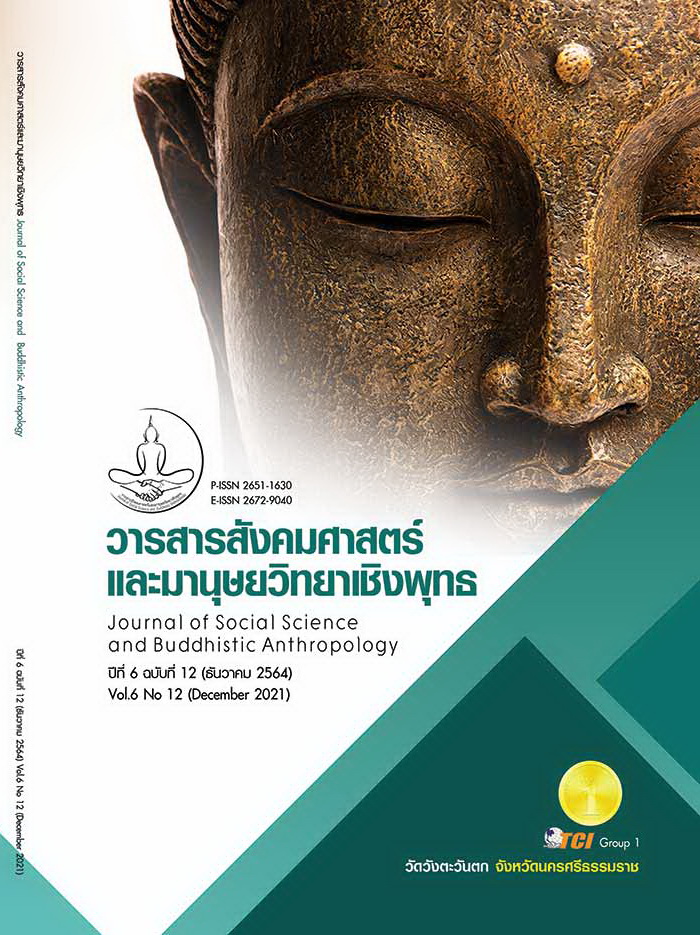THE DEVELOPMENT OF AN EVIDENCE MIND BEHAVIORAL ASSESSMENT TOOL OF NURSING STUDENTS
Keywords:
Behavioral Assessment Tool, Evidence Mind, Nursing StudentsAbstract
The objectives of this research article were to study the components and develop evidence mind's behavioral assessment tool of nursing students by a research on mixed methods. The qualitative research studied evidence mind components, key informants were registered nurses who received an outstanding nurse award and experienced in evidence - based practice with eight persons. Data were collected by in - depth interviews using a semi - structured interview and analyzed data with content analysis. The quantitative research developed evidence mind's behavioral assessment tool, the simple random sampling was thirty-five fourth-year nursing students from Faculty of Nursing at Srinakharinwirot university. Data were collected by using Behaviorally Anchored Rating Scale:BARS and evaluated quality assessment tool. Research findings were as follows: 1) The nursing student's evidence mind components consist of three main components. 1) Intention, consists of three sub - components: belief, self - esteem and desire; 2) Critical inquiry evidence, consists of three sub - components: making inquiries, being assertive, and critical thinking; and 3) Evidence - based ability, consists of four sub - components: questioning, searching for evidence, verifying evidence, applying and evaluating evidence. Evidence mind's behavioral assessment tool was developed as a performance behavior appraisal 5 levels: perception, understanding, response, merged mind and character. 2) The quality of components and evidence mind's behavioral assessment tool found that content validity IOC between 0.56 - 1.00. Reliability testing results by Inter - Rater Reliability (IRR) was a statistically significant consistency (p<.01) with Pearson's correlation coefficient (r) = .892 and correlation coefficient alpha Cronbach reliability = .91
References
ธีรารักษ์ นำภานนท์ และคณะ. (2558). ปัจจัยที่สัมพันธ์กับการปฏิบัติตามหลักฐานเชิงประจักษ์ของพยาบาลกุมารเวชศาสตร์ในเขตภาคเหนือ. พยาบาลสาร 42(ฉบับพิเศษ), 49-60.
นุสรา ประเสริฐศรี และคณะ. (2559). ผลของโปรแกรมการสอนตามแนวคิดการใช้หลักฐานเชิงประจักษ์ ต่อสมรรถนะการพยาบาลตามหลักฐานเชิงประจักษ์ในนักศึกษาพยาบาล. วารสารการพยาบาล การสาธารณสุขและการศึกษา, 17(3), 145-155.
ผู้ให้สัมภาษณ์ A. (28 พฤษภาคม 2562). องค์ประกอบและการเสริมสร้างจิตประจักษ์หลักฐานของนักศึกษาพยาบาล. (วิภาวรรณ นำศรีเจริญกุล, ผู้สัมภาษณ์)
ผู้ให้สัมภาษณ์ B. (30 พฤษภาคม 2562). องค์ประกอบและการเสริมสร้างจิตประจักษ์หลักฐานของนักศึกษาพยาบาล. (วิภาวรรณ นำศรีเจริญกุล, ผู้สัมภาษณ์)
ผู้ให้สัมภาษณ์ C. (23 พฤษภาคม 2562). องค์ประกอบและการเสริมสร้างจิตประจักษ์หลักฐานของนักศึกษาพยาบาล. (วิภาวรรณ นำศรีเจริญกุล, ผู้สัมภาษณ์)
ผู้ให้สัมภาษณ์ D. (12 มิถุนายน 2562). องค์ประกอบและการเสริมสร้างจิตประจักษ์หลักฐานของนักศึกษาพยาบาล. (วิภาวรรณ นำศรีเจริญกุล, ผู้สัมภาษณ์)
ผู้ให้สัมภาษณ์ E. (5 มิถุนายน 2562). องค์ประกอบและการเสริมสร้างจิตประจักษ์หลักฐานของนักศึกษาพยาบาล. (วิภาวรรณ นำศรีเจริญกุล, ผู้สัมภาษณ์)
ผู้ให้สัมภาษณ์ F. (6 มิถุนายน 2562). องค์ประกอบและการเสริมสร้างจิตประจักษ์หลักฐานของนักศึกษาพยาบาล. (วิภาวรรณ นำศรีเจริญกุล, ผู้สัมภาษณ์)
ผู้ให้สัมภาษณ์ G. (7 มิถนายน 2562). องค์ประกอบและการเสริมสร้างจิตประจักษ์หลักฐานของนักศึกษาพยาบาล. (วิภาวรรณ นำศรีเจริญกุล, ผู้สัมภาษณ์)
ผู้ให้สัมภาษณ์ H. (31 พฤษภาคม 2562). องค์ประกอบและการเสริมสร้างจิตประจักษ์หลักฐานของนักศึกษาพยาบาล. (วิภาวรรณ นำศรีเจริญกุล, ผู้สัมภาษณ์)
มัฏฐวรรณ ลี้ยุทธานนท์ และคณะ. (2561). ทฤษฎีพฤติกรรมตามแผนกับความตั้งใจออกกำลังกายด้วยการเดินในผู้ป่วยภายหลังเกิดโรคหลอดเลือดสมอง. วารสารพยาบาลทหารบก, 19(1), 47-55.
ล้วน สายยศ และอังคณา สายยศ. (2547). การวัดด้านจิตพิสัย. กรุงเทพมหานคร: โรงพิมพ์สุวีริยาสารส์น.
ลัดดาวัลย์ พุทธรักษาและคณะ. (2559). ปัจจัยสู่ความสำเร็จในการใช้หลักฐานเชิงประจักษ์ทางการพยาบาลของพยาบาลวิชาชีพ. วารสารคณะพยาบาลศาสตร์ มหาวิทยาลัยบูรพา, 24(3), 94-103.
วรรณเพ็ญ อินทร์แก้ว และสมจินดา ชมพูนุท. (2558). ประสิทธิผลของการเรียนการสอนโดยการใช้หลักฐานเชิงประจักษ์ต่อการใฝ่รู้และความสามารถในการปฏิบัติการพยาบาลของนักศึกษาพยาบาล. วารสารพยาบาลตำรวจ, 7(2), 201-214.
วิโรจ นาคชาตรี. (2553). ปรัชญาจิต : Philosophy of mind (PY 236). กรุงเทพมหานคร: สำนักพิมพ์มหาวิทยาลัยรามคำแหง.
วิลาวัณย์ พิเชียรเสถียร. (2555). Using Evidence to Improving Nursing Outcome. เรียกใช้เมื่อ 22 สิงหาคม 2560 จาก http://www.med.cmu.ac.th/hospital/nis/nurse_day/file/2012_10_17/evidence.pdf
สภาการพยาบาล. (2553). สมรรถนะผู้ประกอบวิชาชีพการพยาบาลและการผดุงครรภ์. กรุงเทพมหานคร: ศิริยอดการพิมพ์.
สมจิตรา เรืองศรี. (2554). การสร้างแบบวัดจิตพิสัย = Affctive test construction : MR 413. กรุงเทพมหานคร: ภาควิชาการประเมินและการวิจัย มหาวิทยาลัยรามคำแหง.
อรนันท์ หาญยุทธ. (2557). กระบวนการพยาบาลและการนำไปใช้. วารสารพยาบาลทหารบก, 15(3), 137-143.
อาภรณ์ ภู่วิทยพันธุ์. (2559). การพัฒนา Core Competency บนแนวคิด 70:20:10. กรุงเทพมหานคร: เอช อาร์ เซ็นเตอร์.
อินทิรา ไชยณรงค์. (2561). ทฤษฎีพฤติกรรมตามแผนกับความตั้งใจออกกำลังกายด้วยการเดินในผู้ป่วยภายหลังเกิดโรคหลอดเลือดสมอง. วารสารพยาบาลทหารบก, 19(1), 47-55.
Aglen, B. (2016). Pedagogicalstrategies to teach bachelor students evidence - based practice: A systematic review. Nurse Education Today, 36(1), 255-263.
Ajzen, I. (1991). The theory of planned behavior. Organizational behavior and human decision processes, 50(2), 179-211.
Cochran-Smith, M. et al. (2009). “Re - culturing” teacher education: Inquiry, evidence, and action. Journal of Teacher Education, 60(5), 458-468.
Endsley, M. R. (1995). Toward a Theory of Situation Awareness in Dynamic Systems. HUMAN FACTORS, 37(1), 32-64.
Eriksson, K. (2010). Evidence: To See or Not to See. Nursing Science Quarterly, 23(4), 275-279.
Hagger, M. S. et al. (2012). An intervention to reduce alcohol consumption in undergraduatestudents using implementation intentions and mental simulations: A cross - national study. International journal of behavioral medicine, 19(1), 82-96.
Kashima, Y. et al. (1998). The category of the mind: Folk psychology of belief, desire, and intention. Asian Journal of Social Psychology, 1(3), 289-313.
Mackey, A. & Bassendowski, S. (2017). The history of evidence - based practice in nursing education and practice. Journal of Professional Nursing, 33(1), 51-55.
Marshall, C. & Rossman, G. B. (2016). Designing Qualitative research (6th ed.). Los Angeles: California: SAGE.
Maslin, K. T. (2011). An Introduction to the Philosophy of Mind (2nd ed). Great Britain: MPG Books Group.
Melnyk, B. M. et al. (2014). The establishment of evidence - based practice competencies for practicing registered nurses and advanced practice nurses in real - world clinical settings: proficiencies to improve healthcare quality, reliability, patient outcomes, and costs. Worldviews on Evidence - Based Nursing, 11(1), 5-15.
Mousavizadeh, S. N. & Mohtashami, J. (2018). Correlation between professional autonomy and evidence - based practice in nurses. MEDICAL SCIENCE, 22(94), 514-517.
Patelarou, A., E. et al. (2020). Educational Interventions for Teaching Evidence - Based Practice to Undergraduate Nursing Students: A Scoping Review. International Journal of Environmental Research and Public Health, 17(6351), 1-25.
Profetto-McGrath, J. (2005). Critical thinking and evidence - based practice. Journal of Professional Nursing, 21(6), 364-371.
Quesque, F. & Rossetti, Y. (2020). What do theory - of - mind tasks actually measure? Theory and practice. Perspectives on Psychological Science, 15(2), 384-396.
Schaffer, M. A. et al. (2013). Evidence - based practice models for organizational change: overview and practical applications. Journal of advanced nursing, 69(5), 1197-1209.
Sin, M. K. & Bliquez, R. (2017). Teaching evidence based practice to undergraduate nursing students. Journal of Professional Nursing, 33(6), 447-451.
WALL, S. (2008). A Critique of Evidence - Based Practice in Nursing: Challenging the Assumptions. Social Theory & Health, 6(1), 37-53.








